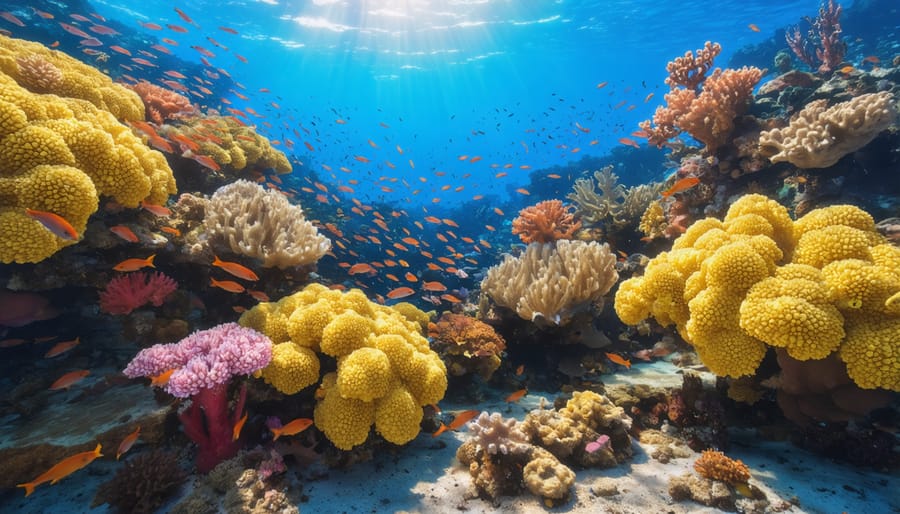
Beneath the waves, a symphony of life unfolds, interconnected and essential. Marine biodiversity is the foundation upon which countless species thrive, from microscopic plankton to majestic whales. This intricate tapestry of life is not only awe-inspiring but also vital for life on Earth.
The ocean’s bounty sustains billions of people worldwide, providing food security, livelihoods, and cultural heritage. Marine ecosystems act as the planet’s lungs, absorbing carbon dioxide and producing oxygen. They regulate climate, protect coastlines, and hold untapped potential for medical discoveries.
Yet, this precious biodiversity faces grave threats from human activities. Overfishing, pollution, habitat destruction, and climate change are unraveling the delicate balance of marine life. The consequences are far-reaching, impacting not only the ocean’s inhabitants but also the well-being of humanity.
It is imperative that we recognize the immense value of marine biodiversity and take action to safeguard it. Through sustainable fishing practices, reduced pollution, protected areas, and global cooperation, we can chart a course towards a thriving ocean. The future of our planet depends on the health and resilience of its blue heart—the marine realm.
The Web of Marine Life

The Role of Keystone Species
Keystone species play a vital role in maintaining the delicate balance of marine ecosystems. These species, such as sea otters, sea stars, and parrotfish, have a disproportionately large impact on their environment relative to their abundance. For instance, sea otters keep sea urchin populations in check, preventing them from overgrazing kelp forests. Without sea otters, these underwater forests would be decimated, leading to a cascade of negative effects on the entire ecosystem. Similarly, sea stars are critical predators that help control the populations of mussels and barnacles, while parrotfish consume algae, allowing coral reefs to thrive. The loss of keystone species can lead to dramatic shifts in marine habitats, underscoring the importance of protecting these crucial animals. By understanding the interconnectedness of marine life and the role of keystone species, we can better appreciate the significance of marine biodiversity and work towards its conservation.
The Dangers of Biodiversity Loss
The loss of even a single species can have far-reaching consequences for marine ecosystems. In the intricate web of life, each organism plays a vital role. When a species disappears, it can trigger a domino effect that disrupts the delicate balance of the ecosystem. For example, the extinction of a key predator can lead to an unchecked population growth of its prey, which in turn can overgraze and deplete the habitat. Similarly, the loss of a critical species like coral can destroy entire reef systems that provide shelter and nursery grounds for countless other species. These cascading effects can ultimately lead to the collapse of entire food chains and the degradation of ecosystem services that humans rely on, such as fisheries, coastal protection, and tourism. Protecting every species, no matter how small or seemingly insignificant, is crucial for maintaining the resilience and health of our oceans.
Marine Biodiversity and Human Well-being

Food Security
Marine life plays a vital role in food security, sustaining billions of people worldwide. Fish and other seafood are the primary source of protein for over 3 billion people, with many coastal communities relying on these resources for their livelihoods. Healthy marine ecosystems, such as coral reefs, mangroves, and seagrass beds, provide critical habitats for commercially important fish species, ensuring a stable food supply. However, overfishing, destructive fishing practices, and habitat degradation threaten the long-term sustainability of these resources. Protecting marine biodiversity is essential to maintain the ocean’s capacity to provide food security for current and future generations. By implementing sustainable fishing practices, establishing marine protected areas, and supporting responsible aquaculture, we can safeguard the ocean’s bounty while meeting the growing global demand for seafood. Preserving marine biodiversity is not only an environmental imperative but also a critical step in ensuring food security for the world’s population.
Economic Benefits
Marine biodiversity holds immense economic value for coastal communities and nations worldwide. Fisheries, which rely on healthy marine ecosystems, provide livelihoods for millions and feed billions. Diverse marine life also supports thriving tourism industries, from whale watching to snorkeling on coral reefs. Pristine beaches and abundant sea life attract visitors, generating income for local businesses. Furthermore, the vast genetic diversity in the oceans holds promise for medical breakthroughs. Many marine organisms produce unique compounds that could lead to new treatments for diseases like cancer and Alzheimer’s. By protecting marine biodiversity, we safeguard these economic benefits and ensure a sustainable future for the communities that depend on the ocean’s bounty. Investing in marine conservation is not only an environmental imperative but also an economically sound decision that supports jobs, fuels innovation, and secures the well-being of countless people around the globe.
Coastal Protection
Healthy marine ecosystems act as natural buffers, protecting coastal communities from the devastating impacts of storms, erosion, and flooding. Coral reefs, mangrove forests, and seagrass beds dissipate wave energy, reducing the force of storms and minimizing damage to coastal infrastructure. These ecosystems also stabilize sediments and prevent coastal erosion, helping to maintain the integrity of shorelines. Furthermore, they absorb excess water during high tides and storm surges, mitigating the risk of flooding in low-lying areas. By preserving marine biodiversity and the health of these protective ecosystems, we can enhance the resilience of coastal communities in the face of increasingly frequent and intense weather events.
Marine Biodiversity and Climate Change

Carbon Sequestration
Marine life plays a crucial role in carbon sequestration, helping to mitigate the effects of climate change. Through photosynthesis, marine plants and algae absorb vast amounts of carbon dioxide from the atmosphere, converting it into organic matter. When these organisms die, they sink to the ocean floor, effectively storing the carbon for centuries or even millennia. Additionally, marine animals like corals and mollusks build their skeletons and shells using calcium carbonate, which also removes carbon from the water. Healthy marine ecosystems, with their diverse array of species, can sequester up to 20 times more carbon per acre than terrestrial forests. Protecting and restoring marine biodiversity is essential for maintaining this vital carbon sink and combating climate change. By supporting conservation efforts and reducing our carbon footprint, we can help ensure that the ocean continues to serve as a powerful ally in the fight against global warming.
Ocean Acidification
Ocean acidification is a growing threat to marine biodiversity, as rising CO2 levels cause seawater to become more acidic. This process impairs the ability of calcifying organisms like corals, mollusks, and crustaceans to build their protective shells and skeletons. As biodiversity declines, the resilience of marine ecosystems to cope with acidification diminishes. Diverse ecosystems are more likely to contain species that can adapt to changing conditions and maintain critical functions. However, as species are lost, the intricate relationships that help buffer against environmental stressors unravel. This vicious cycle underscores the urgent need to protect marine biodiversity in the face of climate change. By preserving the variety of life in our oceans, we enhance their capacity to withstand and recover from the impacts of acidification. Every action to conserve biodiversity, from reducing carbon emissions to supporting sustainable fishing practices, helps fortify our oceans against this global threat.
Protecting Marine Biodiversity
Sustainable Fishing Practices
Consumers play a vital role in promoting sustainable fishing practices by choosing seafood sourced from well-managed fisheries that minimize bycatch and habitat damage. Look for eco-labels like the Marine Stewardship Council (MSC) or Aquaculture Stewardship Council (ASC) certifications, which indicate responsibly caught or farmed seafood. By supporting sustainable fishing practices, we can reduce the pressure on overexploited species, allow depleted populations to recover, and maintain the delicate balance of marine ecosystems. Making informed choices about the seafood we consume sends a powerful message to the fishing industry and encourages the adoption of more sustainable methods. Together, our individual actions can drive positive change and ensure the long-term health of our oceans and the incredible biodiversity they support.
Reducing Pollution
To minimize the impact of pollution on marine ecosystems, we can all take steps to reduce plastic waste and other harmful pollutants. Choose reusable bags, water bottles, and straws instead of single-use plastics. Properly dispose of waste and participate in beach clean-ups to prevent litter from entering the ocean. Support businesses that use eco-friendly packaging and avoid products containing microbeads. Opting for natural, biodegradable cleaning products and properly disposing of hazardous materials like batteries and electronics also helps protect marine life. By making sustainable choices and advocating for reducing pollution, we can all contribute to the health and resilience of our precious marine ecosystems.
Supporting Conservation Efforts
Many organizations are working tirelessly to protect marine biodiversity. The Ocean Conservancy, for example, organizes annual coastal cleanups and advocates for sustainable fishing practices. The Marine Conservation Institute works to establish marine protected areas and combat illegal fishing. Greenpeace campaigns against destructive fishing methods and plastic pollution. Readers can support these efforts by volunteering, donating, or spreading awareness. Simple actions like reducing plastic use, choosing sustainably sourced seafood, and participating in beach cleanups can make a difference. By supporting conservation organizations and making eco-friendly choices, individuals can play a crucial role in preserving the incredible diversity of life in our oceans.
Conclusion
Marine biodiversity is the foundation of life in our oceans, supporting intricate ecosystems, sustaining human well-being, and playing a crucial role in regulating the Earth’s climate. As we have explored, the incredible variety of marine species, from microscopic plankton to majestic whales, is interconnected in a delicate balance that is now under threat from human activities. The loss of marine biodiversity has far-reaching consequences, not only for the health of our oceans but also for the billions of people who depend on them for food, livelihoods, and cultural identity.
It is imperative that we take urgent action to protect and restore marine biodiversity before it is too late. This requires a collective effort from governments, industries, scientists, and individuals to reduce the pressures on marine ecosystems, such as overfishing, pollution, and climate change. By supporting sustainable fishing practices, reducing our carbon footprint, and participating in conservation initiatives, we can all contribute to safeguarding the incredible diversity of life in our oceans.
The future of our planet and our own well-being are inextricably linked to the health of marine biodiversity. By recognizing its importance and taking action to protect it, we can ensure that the wonders of the ocean continue to inspire and sustain us for generations to come.
jessica
Ava Singh is an environmental writer and marine sustainability advocate with a deep commitment to protecting the world's oceans and coastal communities. With a background in environmental policy and a passion for storytelling, Ava brings complex topics to life through clear, engaging content that educates and empowers readers. At the Marine Biodiversity & Sustainability Learning Center, Ava focuses on sharing impactful stories about community engagement, policy innovations, and conservation strategies. Her writing bridges the gap between science and the public, encouraging people to take part in preserving marine biodiversity. When she’s not writing, Ava collaborates with local initiatives to promote eco-conscious living and sustainable development, ensuring her work makes a difference both on the page and in the real world.
